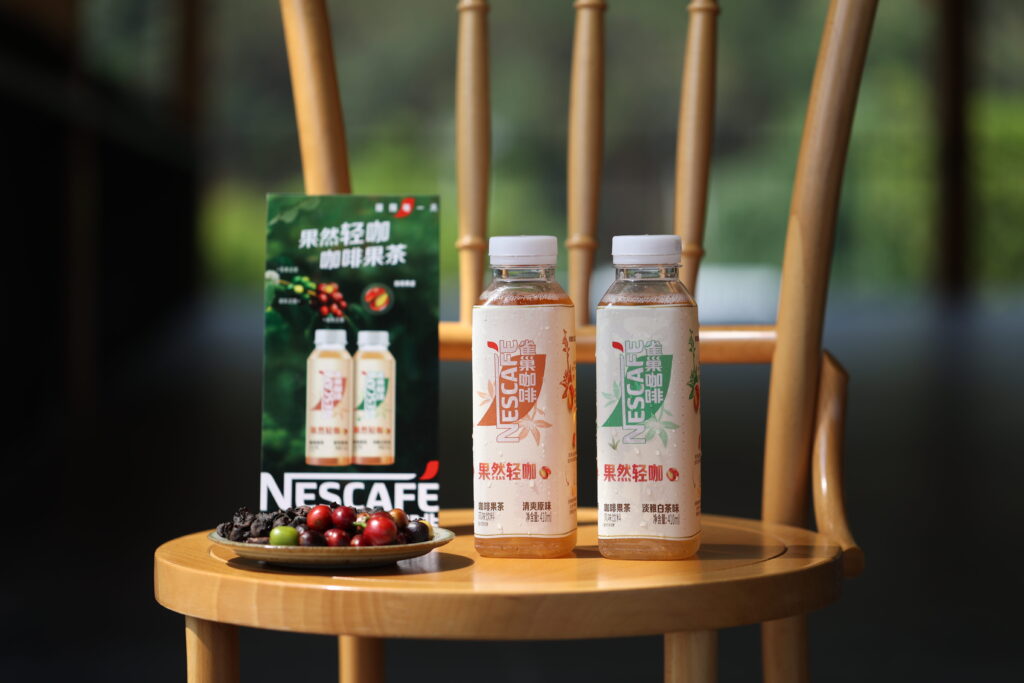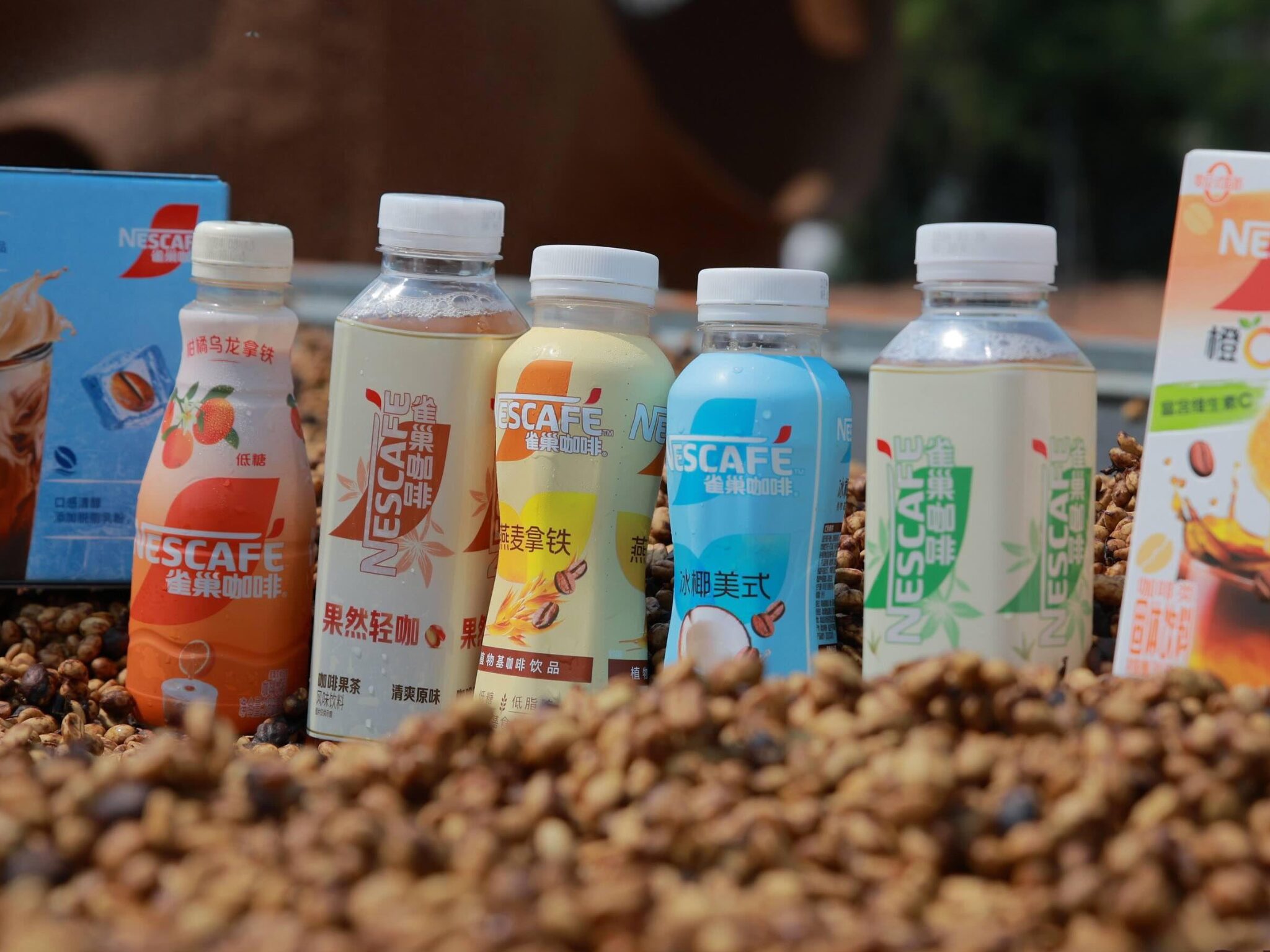5 Mins Read
Nestlé has introduced six new coffee lines to China, which include plant-based beverages and a first-of-its-kind upcycled innovation.
Already a market leader for 36 years now, global CPG giant Nestlé has invigorated its coffee portfolio in China to meet the growing demand for sustainable, plant-based bottled drinks.
Part of the new range are two vegan ready-to-drink offerings (Coconut Americano and Oatmeal Latte) and an upcycled coffee offering (Guoran Light Coffee) that is new to the Chinese market. The shake-up, which sees all sub-brands integrated into the Nescafé lineup, comes as Nestlé aims to consolidate its position in the country’s evolving coffee sector.
“Consumers’ coffee consumption is increasing, from initially one cup a day to possibly two to three cups a day. For us, this is an opportunity,” Alfonso Troisi, senior VP for coffee at Nestlé Greater China, said in a press chat at the FBIC summit last month. “As consumers enjoy coffee in more scenarios, we also need to expand more applicable products.”
Keying into consumer preferences

The Coconut Americano contains over 20% coconut water and is low in sugar and fat content, while the oat-based Oatmeal Latte has 7g of dietary fibre (which is why it’s positioned as a breakfast option).
This will speak to the increasingly health-conscious Chinese consumer. A 2023 report by Asymmetrics Research noted how milk alternative brands are highlighting attributes like ‘no sugar/cholesterol/trans fat’, ‘good for brains/eyes’, and ‘high protein/calcium’ on product packaging, alongside cleaner labels.
“China is promoting healthier and more nutritious food options in response to the Healthy China policy,” said David J Ettinger, chief representative officer at law firm Keller and Heckman Shanghai. “Therefore, foods offering health benefits and high nutritional value are going to likely lead the way. Chinese consumers will look to healthier options, like alt-proteins, so it will be up to the alt-protein industry to demonstrate that these novel foods provide another nutritious option for consumers.”
Moreover, the use of coconut and oat is a shrewd move from Nestlé, as Chinese consumers have indicated their preference for these flavours. There are more oat milk options in China than any other plant-based alternatives, thanks to its dominance in coffee. In tier 1 and 2 cities, oat and coconut have become common milk choices in lattes.
As for the upcycled beverage, this makes use of cascara, the outer husk of coffee cherries that are typically discarded. In many cultures and countries, this red ‘coffee fruit’ is used to make hot and iced teas, and it’s something increasingly being adopted by specialty coffee companies.
Cascara has a slightly sweet and fruity flavour, and while it does contain caffeine, it’s present in much smaller amounts than the seeds enclosed within, Troiso explained. “In Yunnan, people will make coffee peels into coffee fruit tea for drinking. Therefore, we use it as the main ingredient to make it a drinkable drink every day,” he added.
The Nestlé executive suggested that this product – the result of 10 years of work – was launched with the circular economy and the regenerative food system in mind. “The use of the same coffee bean has expanded from the conventional method of making coffee to the use of the entire coffee fruit, including the peel, and its value has been fully explored,” he said.
“Chinese consumers still like fruit tea flavours, whether it is fruit juice, or other flavoured and tea-based beverages. Therefore, we hope that in addition to coffee lovers, we will also want some other users to try this new product.”
Taking on the Chinese coffee boom

Coffee consumption in China is increasing, with people drinking two to three cups a day. The market reached 617.8 billion yuan ($85.5B) in 2023, and is slated to surpass the trillion-yuan mark ($138B) by next year. It has resulted in increased competition between coffee companies like Luckin, Costa, Starbucks, as well as Nestlé. While it dominates the instant coffee realm, the latter’s targeted move into bottled drinks represents its need – and willingness – to adapt.
“China has a highly dynamic coffee market and growth, and tends to form its own unique and constantly evolving coffee consumption trends,” Troiso told FoodNavigator-Asia. “Based on insights into the local coffee market, we have rearranged our product lines based on consumption scenarios and target groups to ensure better and more targeted product innovation based on consumer needs.”
In fact, last year, Nestlé appointed its first local R&D head for Greater China to identify emerging market trends and preferences of younger consumers. The conglomerate has also shortened its product launch cycle from 12-18 months to eight to 10 months, and is now aiming to bring that down to six months. Nescafé, meanwhile, will soon launch a coffee innovation centre in Shanghai to capitalise on the coffee opportunity.
“We pay close attention to the various stages of consumers’ lives and what kind of coffee needs they have in those stages,” Troiso said at FBIF. “We found that the majority of Chinese users were exposed to coffee for the first time during the gaokao [the national college entrance exam]… As they enter the workforce, their needs change, and we adapt our products to those changes.”
He added: “Our goal is to be a brand that can stay close to the needs of consumers, such as providing products that lift spirits and meet the needs of different user groups. We want to create a brand image that is close to the minds of consumers. In recent years, we have also worked to promote the sustainability of coffee, which has also resonated more with young people.”
Troiso suggested sustainability is the joint responsibility of the entire industry, reiterating Nescafé’s 2030 plan of cutting emissions in half and sourcing 50% of its coffee through regenerative agriculture by the year. “We have clear targets to reduce carbon emissions, so we have taken different measures at all levels,” he said.
“In addition, consumer awareness is also very important. We strive to educate consumers about the sustainability of coffee and share information about sustainable coffee, because consumer choices drive progress on sustainable projects.”



